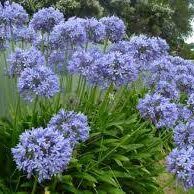Seasonal Agapanthus Treatment: Getting Ready For Winter Season and Summer
Seasonal Agapanthus Treatment: Getting Ready For Winter Season and Summer
Blog Article
Understanding the Art of Agapanthus Treatment: Necessary Actions for Healthy And Balanced Growth and Vivid Blossoms
In the realm of horticulture, the growing of agapanthus stands as a gratifying venture for those that seek to nurture these classy flowering plants. From choosing the appropriate range to understanding trimming methods, the trip towards growing growing agapanthus plants is multifaceted and holds the vital to unlocking the complete possibility of these herb treasures.

Selecting the Right Agapanthus Range

When picking the right Agapanthus range for your garden, take into consideration elements such as environment suitability, flower color, and development routine. In addition, think about the climate in your region to make certain the Agapanthus range you pick can flourish in your particular conditions. Comprehending the development routine of different Agapanthus ranges is important for proper placement within your garden.
Ideal Growing Problems
Considering the ideal ecological demands is important for effective Agapanthus farming. Agapanthus flourishes in well-draining soil with a slightly acidic to neutral pH level. When growing, choose a location that receives complete sunshine to partial color. In hotter climates, providing some mid-day shade can avoid scorching of the leaves. Agapanthus plants are delicate to cool temperature levels and should be safeguarded from frost during winter months.
To make sure healthy development and lively blooms, plant Agapanthus light bulbs at a deepness of about 2-4 inches and space them 8-12 inches apart. Mulching around the base of the plants aids maintain moisture and suppresses weed development.
Watering and Fertilizing Tips
Preserving proper wetness degrees and offering vital nutrients are key components in the care routine for Agapanthus plants. When it comes to watering Agapanthus, it is crucial to strike an equilibrium. These plants choose continually wet soil but are susceptible to root rot if overwatered. Throughout the expanding period, water deeply once a week, ensuring the soil is well-draining to stop waterlogging. In hotter climates or throughout durations of dry spell, more frequent watering might be needed to maintain the dirt equally damp. However, reduce watering in the winter season to avoid waterlogged conditions.
Fertilizing Agapanthus is essential for advertising healthy growth and prolific blooms. Use a well balanced plant food, such as a 10-10-10 formula, in the early springtime as new growth arises. Repeat this application every 6-8 weeks throughout the expanding period. Avoid too much fertilizing, as it can lead to lavish foliage at the expenditure of flowers. Constantly adhere to the supplier's directions for correct dilution and application methods. By adhering to these watering and fertilizing pointers, you can guarantee your Agapanthus plants flourish and create lively, resilient blooms.
Trimming Methods for Agapanthus
Trimming Agapanthus plants at the suitable times and with proper methods is crucial for maintaining their health and wellness and advertising optimum growth and blooming. The optimal time to prune Agapanthus remains in late winter or early springtime before brand-new development emerges. Begin by eliminating any kind of yellowing or dead fallen leaves near the base of the plant. Cut them as short as possible without damaging the arising shoots.
For flowered stems, wait till the blossoms have perished and afterwards cut them back to the base. This not just tidies up the plant's appearance but likewise motivates the growth of new flower buds. Deadheading invested flowers can likewise redirect the plant's power right into generating more blooms as opposed to establishing seeds. Nonetheless, if you wish to accumulate seeds for proliferation, leave some find blossoms to fully grown and completely dry on the plant.
Bear in mind to make use of tidy, sharp devices to make exact cuts and reduce the threat of presenting illness. Agapanthus. Routine trimming will certainly assist keep your Agapanthus looking healthy and balanced and neat while guaranteeing a plentiful display screen of lovely flowers
Dealing With Usual Pests and Conditions
After making certain appropriate trimming methods for Agapanthus, it is necessary to address typical bugs and conditions that can impact the wellness and vitality of these plants. Agapanthus plants are usually sturdy yet can still succumb to specific issues. One common parasite that impacts Agapanthus is the Agapanthus gall midge. This little, orange fly lays its eggs in the foliage, bring about distorted development and flower buds that fall short to open. To fight this pest, prune and damage any damaged plant parts and think about using insecticidal soap.
One more usual issue is fungal leaf area, which offers as dark lesions on the leaves. To stop fungal diseases, guarantee great air blood circulation around the plants, avoid imp source above watering, site link and eliminate any kind of contaminated fallen leaves without delay. Additionally, Agapanthus plants can experience origin rot if they are grown in improperly draining pipes dirt. To stop this, plant Agapanthus in well-draining dirt and stay clear of overwatering. By being watchful and taking timely action against parasites and diseases, you can aid your Agapanthus plants grow and generate lively blooms.

Conclusion
Finally, understanding the art of agapanthus treatment includes choosing the best variety, offering optimal planting problems, correct watering and fertilizing, suitable pruning strategies, and resolving typical insects and diseases. By adhering to these vital steps, you can make sure healthy development and lively flowers for your agapanthus plants. Remember to regularly check and preserve your plants to promote their total wellness and long life.
To make sure healthy development and dynamic blooms, plant Agapanthus bulbs at a deepness of regarding 2-4 inches and room them 8-12 inches apart. By complying with these watering and feeding ideas, you can ensure your Agapanthus plants flourish and produce vivid, resilient blooms.
One common bug that affects Agapanthus is the Agapanthus gall midget. Additionally, Agapanthus plants can suffer from origin rot if they are planted in improperly draining soil. By adhering to these essential steps, you can make sure healthy growth and dynamic blossoms for your agapanthus plants.
Report this page